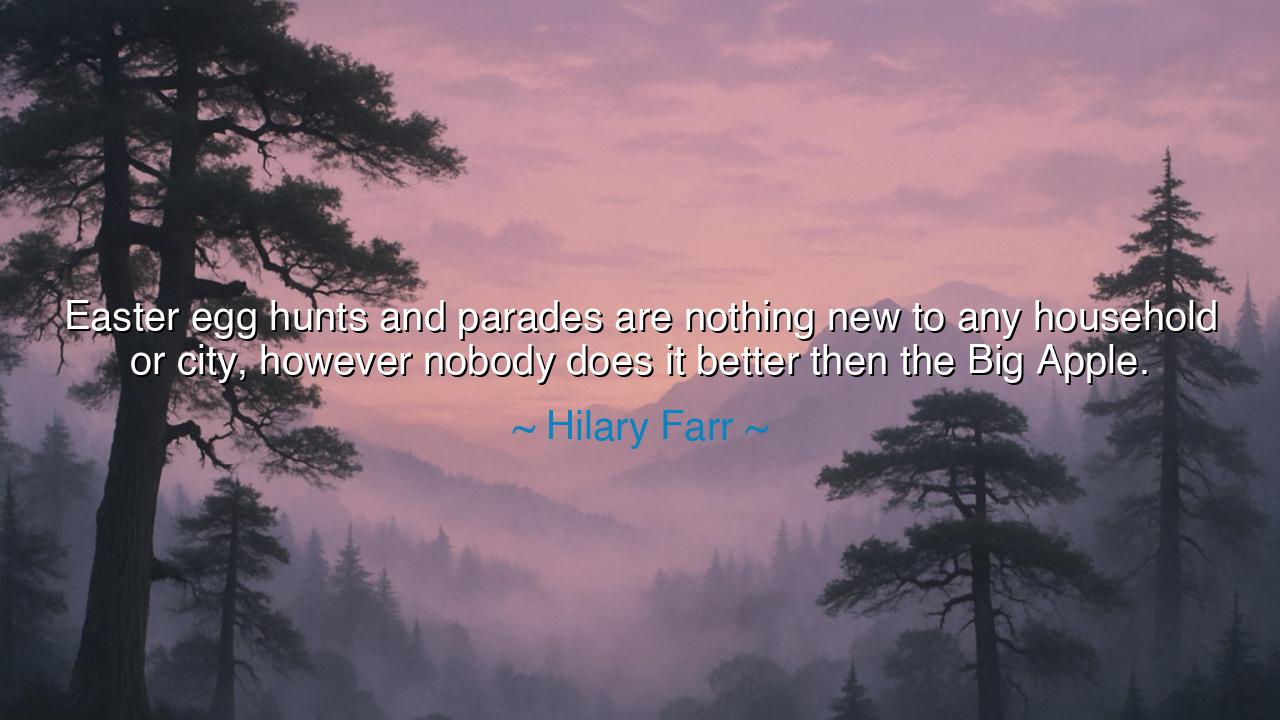
Easter egg hunts and parades are nothing new to any household or
Easter egg hunts and parades are nothing new to any household or city, however nobody does it better then the Big Apple.






“Easter egg hunts and parades are nothing new to any household or city, however nobody does it better than the Big Apple.” Thus spoke Hilary Farr, designer, creator, and lover of beauty — a woman who sees not only the structure of walls and rooms, but the spirit that moves within them. Her words, though spoken of New York City, reach beyond celebration or spectacle. They speak of the human need for festivity, for gathering, for creating color and life out of the ordinary — and of how, in places where humanity converges in its greatest numbers, that joy shines brightest.
In these words, Farr pays homage to tradition, but also to excellence — to the idea that even in something as familiar as an Easter egg hunt or parade, there is a way to transform the simple into the magnificent. “Nothing new,” she says, for indeed, the rituals of Easter — the hunt, the feast, the song, the parade — have been practiced for centuries, carried across cultures and lands. Yet it is in New York, that eternal city of reinvention, where the ancient finds new life. There, tradition is not static; it is renewed each year through scale, imagination, and shared spirit. Her words are both a celebration and a reminder: that greatness does not always come from novelty — it comes from the art of doing familiar things with unmatched passion.
The Easter parade, that luminous procession along Fifth Avenue, is more than a show of bonnets and bands — it is a symbol of resilience and joy. Its roots stretch back to the mid-19th century, when the wealthy of New York would emerge from church in their finest clothes, strolling through the streets as a display of springtime renewal. Over time, the parade became a festival for all, a great equalizer where rich and poor, old and young, gathered beneath the same blooming sky to celebrate life’s return. Farr’s admiration for the Big Apple lies in this very transformation — in the way the city takes an old ritual and infuses it with democratic grandeur.
To say that “nobody does it better than the Big Apple” is to speak of the spirit of creation itself. For New York is not merely a city; it is a living organism, ever pulsating with ambition, diversity, and celebration. Its people come from every corner of the earth, bringing their customs, colors, and dreams. When they gather for Easter, they weave these differences into a single tapestry of joy. The Easter egg, symbol of rebirth and possibility, reflects the city itself — hard-shelled yet full of hidden beauty, waiting to be discovered. Farr sees this not merely as a holiday, but as a metaphor for the city’s soul: its ability to turn tradition into art, and chaos into unity.
Think, too, of how the ancients celebrated the turning of seasons. In the festivals of spring, from the pagan rites of Ostara to the Roman Floralia, humanity marked the death of winter and the return of life. The people danced, adorned themselves, and filled their cities with music and bloom. Farr’s New York stands in this same lineage — the modern echo of those ancient revelries. The Easter parade is the heir to millennia of human hope, a ritual that declares: no matter how long the darkness, the light returns. And in the city that never sleeps, the light shines brighter than anywhere else.
Her statement, however, is more than admiration; it is a call to creativity. Farr reminds us that beauty lies not in invention alone, but in interpretation — in taking what has always been and making it new through love, effort, and vision. The Big Apple’s greatness comes not from having invented celebration, but from its people’s refusal to perform it half-heartedly. In every egg hidden, every hat worn, every note played along Fifth Avenue, there is intention. The city teaches that the smallest acts, when done with care and exuberance, can become extraordinary.
So, my listener, let this lesson take root within you: whatever you do — whether you build, create, teach, or love — do it not as the world expects, but as New York does its parades — with heart, with courage, with unrelenting joy. Do not seek to make everything new; instead, make what already exists shine brighter. For there is wisdom in what is old and magic in what is shared. Let your traditions, like the Easter celebrations of the Big Apple, become moments of unity and rebirth — a reminder that greatness lies not only in originality, but in the spirit of renewal that you bring to everything you touch.
Thus, in the words of Hilary Farr, we find a truth both simple and profound: that the familiar, when infused with passion, can become the divine. The Easter egg hunt and parade, though ancient and ordinary, become in New York a testament to human joy — a living emblem of how tradition, when embraced by the bold and the loving, can rise again in beauty, year after year, as surely as spring itself.






AAdministratorAdministrator
Welcome, honored guests. Please leave a comment, we will respond soon